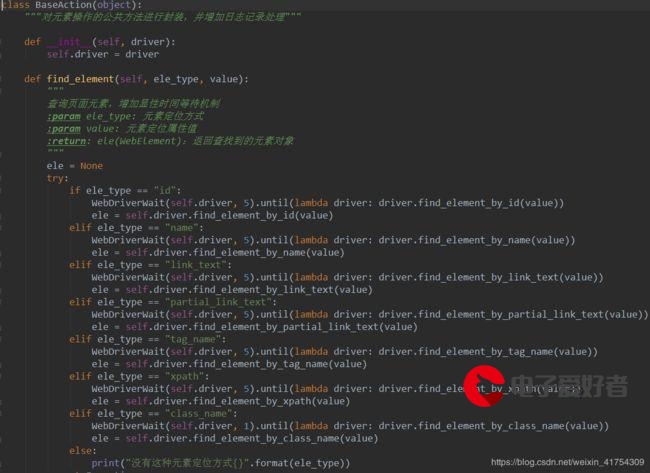 按键驱动分析"/>
按键驱动分析"/>
按键驱动分析
愿得韶华刹那,开得满树芳华 ——也顾偕 《梦落芳华》相对于前面的LED驱动,按键驱动增加了一部分新的代码,增加了一些概念: 中断:指当出现需要时,CPU暂时停止当前程序的执行转而执行处理新情况的程序和执行过程。这里具体指按键被按下后产生的中断,CPU要处理按键的事件。 去抖:通常的按键所用开关为机械弹性开关,当机械触点断开、闭合时,由于机械触点的弹性作用,一个按键开关在闭合时不会马上稳定地接通,在断开时也不会一下子断开。因而在闭合及断开的瞬间均伴随有一连串的抖动,为了不产生这种现象而作的措施就是按键消抖。软件消抖的方法是不断检测按键值,直到按键值稳定。实现方法:假设未按键时输入1,按键后输入为0,抖动时不定。可以做以下检测:检测到按键输入为0之后,延时5ms~10ms,再次检测,如果按键还为0,那么就认为有按键输入。延时的5ms~10ms恰好避开了抖动期。
接下来让我们逐个分析:
当然,分析驱动代码,还得按照套路来,先看我们的init模块:
static int __init s3c_button_init(void)
{int ret = 0;ret = platform_device_register(&s3c_button_device);if(ret){printk(KERN_ERR "%s: Can't register platform device %d\n", __FUNCTION__, ret); goto fail_reg_plat_dev;}dbg_print("Regist S3C %s Device successfully.\n", DEV_NAME);ret = platform_driver_register(&s3c_button_driver);if(ret){printk(KERN_ERR "%s: Can't register platform driver %d\n", __FUNCTION__, ret); goto fail_reg_plat_drv;}dbg_print("Regist S3C %s Driver successfully.\n", DEV_NAME);return 0;fail_reg_plat_drv:platform_driver_unregister(&s3c_button_driver);
fail_reg_plat_dev:return ret;
}接下来是我们的平台设备和平台驱动:
static struct platform_device s3c_button_device = {.name = "s3c_button",.id = 1,.dev = {.platform_data = &s3c_button_data, .release = platform_button_release,},
};static struct platform_driver s3c_button_driver = { .probe = s3c_button_probe, .remove = s3c_button_remove, .driver = { .name = "s3c_button", .owner = THIS_MODULE, },
};这里注意name的匹配以及这些结构体的赋值咯。
当总线上的设备与驱动匹配成功后,我们进入probe函数:
static int s3c_button_probe(struct platform_device *dev)
{int result = 0;dev_t devno;/* Alloc the device for driver */ if (0 != dev_major) { devno = MKDEV(dev_major, dev_minor); //设备号的获取result = register_chrdev_region(devno, 1, DEV_NAME); } else { result = alloc_chrdev_region(&devno, dev_minor, 1, DEV_NAME); dev_major = MAJOR(devno); }/* Alloc for device major failure */if (result < 0) { printk("%s driver can't get major %d\n", DEV_NAME, dev_major); return result; }/* Initialize button_device structure and register cdev*/ //初始化按键设备以及注册我们的cdev结构体memset(&button_device, 0, sizeof(button_device));button_device.data = dev->dev.platform_data;cdev_init (&(button_device.cdev), &button_fops);button_device.cdev.owner = THIS_MODULE;result = cdev_add (&(button_device.cdev), devno , 1); if (result) { printk (KERN_NOTICE "error %d add %s device", result, DEV_NAME); goto ERROR; }button_device.dev_class = class_create(THIS_MODULE, DEV_NAME); //自动创建结点if(IS_ERR(button_device.dev_class)) { printk("%s driver create class failture\n",DEV_NAME); result = -ENOMEM; goto ERROR; }#if LINUX_VERSION_CODE >= KERNEL_VERSION(2,6,24) device_create(button_device.dev_class, NULL, devno, NULL, DEV_NAME);
#elsedevice_create (button_device.dev_class, NULL, devno, DEV_NAME);
#endifprintk("S3C %s driver version %d.%d.%d initiliazed.\n", DEV_NAME, DRV_MAJOR_VER, DRV_MINOR_VER, DRV_REVER_VER);return 0;ERROR: printk("S3C %s driver version %d.%d.%d install failure.\n", DEV_NAME, DRV_MAJOR_VER, DRV_MINOR_VER, DRV_REVER_VER);cdev_del(&(button_device.cdev)); unregister_chrdev_region(devno, 1);return result;
}那么,我们会问,既然都和前面一样,那我们按键驱动和LED驱动有什么区别呢?
答案就在函数调用上,先看看我们的文件操作结构体:
static struct file_operations button_fops = { .owner = THIS_MODULE,.open = button_open, .read = button_read,.poll = button_poll, .release = button_release,
};static int button_open(struct inode *inode, struct file *file)
{ struct button_device *pdev ; //获得按键设备信息struct s3c_button_platform_data *pdata;int i, result;pdev = container_of(inode->i_cdev,struct button_device, cdev); //通过结构体变量中某个成员的首地址进而获得整个结构体变量的首地址。pdata = pdev->data;file->private_data = pdev;/* Malloc for all the buttons remove dithering timer */pdev->timers = (struct timer_list *) kmalloc(pdata->nbuttons*sizeof(struct timer_list), GFP_KERNEL); //分配去抖时间if(NULL == pdev->timers){printk("Alloc %s driver for timers failure.\n", DEV_NAME);return -ENOMEM;}memset(pdev->timers, 0, pdata->nbuttons*sizeof(struct timer_list)); //memset常用于内存空间的初始化/* Malloc for all the buttons status buffer */pdev->status = (unsigned char *)kmalloc(pdata->nbuttons*sizeof(unsigned char), GFP_KERNEL); //分配存储状态的空间if(NULL == pdev->status){printk("Alloc %s driver for status failure.\n", DEV_NAME);result = -ENOMEM; goto ERROR;}memset(pdev->status, 0, pdata->nbuttons*sizeof(unsigned char)); init_waitqueue_head(&(pdev->waitq)); //初始化等待队列for(i=0; i<pdata->nbuttons; i++) {/* Initialize all the buttons status to UP */pdev->status[i] = BUTTON_UP; //初始化按键状态为UP/* Initialize all the buttons' remove dithering timer */setup_timer(&(pdev->timers[i]), button_timer_handler, i); //初始化定时器,回调函数button_timer_handler/* Set all the buttons GPIO to EDGE_FALLING interrupt mode */s3c2410_gpio_cfgpin(pdata->buttons[i].gpio, pdata->buttons[i].setting); //设置相应管脚为中断模式irq_set_irq_type(pdata->buttons[i].nIRQ, IRQ_TYPE_EDGE_FALLING); 设置下降沿触发中断/* Request for button GPIO pin interrupt */result = request_irq(pdata->buttons[i].nIRQ, s3c_button_intterupt, IRQF_DISABLED, DEV_NAME, (void *)i); //中断的注册,一旦发生中断调用s3c_button_intteruptif( result ){result = -EBUSY;goto ERROR1;}}return 0;ERROR1:kfree((unsigned char *)pdev->status);while(--i) { disable_irq(pdata->buttons[i].nIRQ); free_irq(pdata->buttons[i].nIRQ, (void *)i); }ERROR:kfree(pdev->timers);return result;
}static irqreturn_t s3c_button_intterupt(int irq,void *de_id)
{int i;int found = 0;struct s3c_button_platform_data *pdata = button_device.data;for(i=0; i<pdata->nbuttons; i++){if(irq == pdata->buttons[i].nIRQ) //中断号匹配{found = 1; //判断是否产生中断break;}}if(!found) /* An ERROR interrupt */return IRQ_NONE;/* Only when button is up then we will handle this event */ //如果按键状态一直是为按下,则我们设置其状态为未定,用定时器来去抖if(BUTTON_UP == button_device.status[i]){button_device.status[i] = BUTTON_UNCERTAIN;mod_timer(&(button_device.timers[i]), jiffies+TIMER_DELAY_DOWN);}return IRQ_HANDLED;
}static void button_timer_handler(unsigned long data)
{struct s3c_button_platform_data *pdata = button_device.data;int num =(int)data;int status = s3c2410_gpio_getpin( pdata->buttons[num].gpio );if(LOWLEVEL == status){if(BUTTON_UNCERTAIN == button_device.status[num]) /* Come from interrupt */{//dbg_print("Key pressed!\n");button_device.status[num] = BUTTON_DOWN; //按键按下,传过来的值是downprintk("%s pressed.\n", pdata->buttons[num].name);/* Wake up the wait queue for read()/poll() */ //按键按下,唤醒等待队列中的函数button_device.ev_press = 1; //选择阻塞模式wake_up_interruptible(&(button_device.waitq));}/* Cancel the dithering */mod_timer(&(button_device.timers[num]), jiffies+TIMER_DELAY_UP); //启动定时器,延时等待按键被按下,}else{//dbg_print("Key Released!\n");button_device.status[num] = BUTTON_UP;// enable_irq(pdata->buttons[num].nIRQ);}return ;
}read函数阻塞的实现:
static int button_read(struct file *file, char __user *buf, size_t count, loff_t *ppos)
{ struct button_device *pdev = file->private_data; //将结构体button_device的信息传给这个指针struct s3c_button_platform_data *pdata;int i, ret;unsigned int status = 0;pdata = pdev->data;dbg_print("ev_press: %d\n", pdev->ev_press);if(!pdev->ev_press){if(file->f_flags & O_NONBLOCK) //非阻塞模式{dbg_print("read() without block mode.\n");return -EAGAIN;}else{/* Read() will be blocked here */dbg_print("read() blocked here now.\n"); //阻塞模式,等待中断事件产生,并把此时的进程挂起wait_event_interruptible(pdev->waitq, pdev->ev_press);}}pdev->ev_press = 0;for(i=0; i<pdata->nbuttons; i++) //阻塞进行时{dbg_print("button[%d] status=%d\n", i, pdev->status[i]);status |= (pdev->status[i]<<i); //通过位运算保存按键状态到status中}ret = copy_to_user(buf, (void *)&status, min(sizeof(status), count)); //把数据复制给用户return ret ? -EFAULT : min(sizeof(status), count);
}最后还有个poll函数
static unsigned int button_poll(struct file *file, poll_table * wait)
{ struct button_device *pdev = file->private_data;unsigned int mask = 0;poll_wait(file, &(pdev->waitq), wait);if(pdev->ev_press){mask |= POLLIN | POLLRDNORM; /* The data aviable */ }return mask;
}分析完以上代码,这里说一下我对整个驱动程序逻辑的理解:
执行open函数,初始化等待队列以及定时器,设置按键状态,定时列表指向定时函数,设置按键模式为中断模式并且申请中断,执行poll,监视button节点是否可读,如果可读,执行read,read中被等待队列阻塞,按键标志位为1且队列被唤醒,read继续执行,清除按键标志位,将按键状态按位保存,传到用户空间。
当按键按下的时候,产生中断,然后read又要读取按键的状态,所以来不及同时处理。则read的时候就用等待队列来阻塞进程,等到确定了按键状态之后再唤醒被阻塞的进程。
简单的分析就到这了,下篇文章给出完整驱动程序以及按键点亮LED的测试程序。
更多推荐
按键驱动分析












发布评论